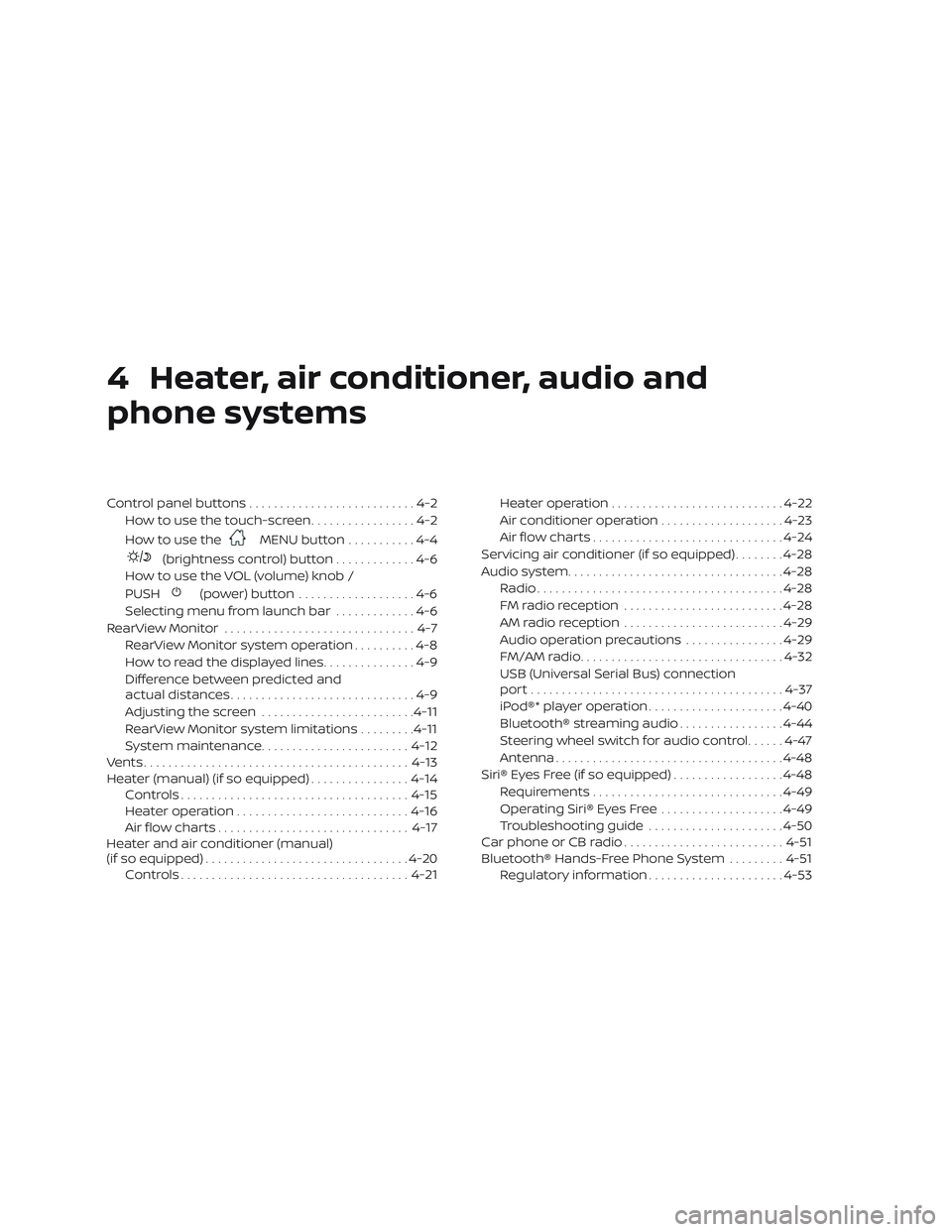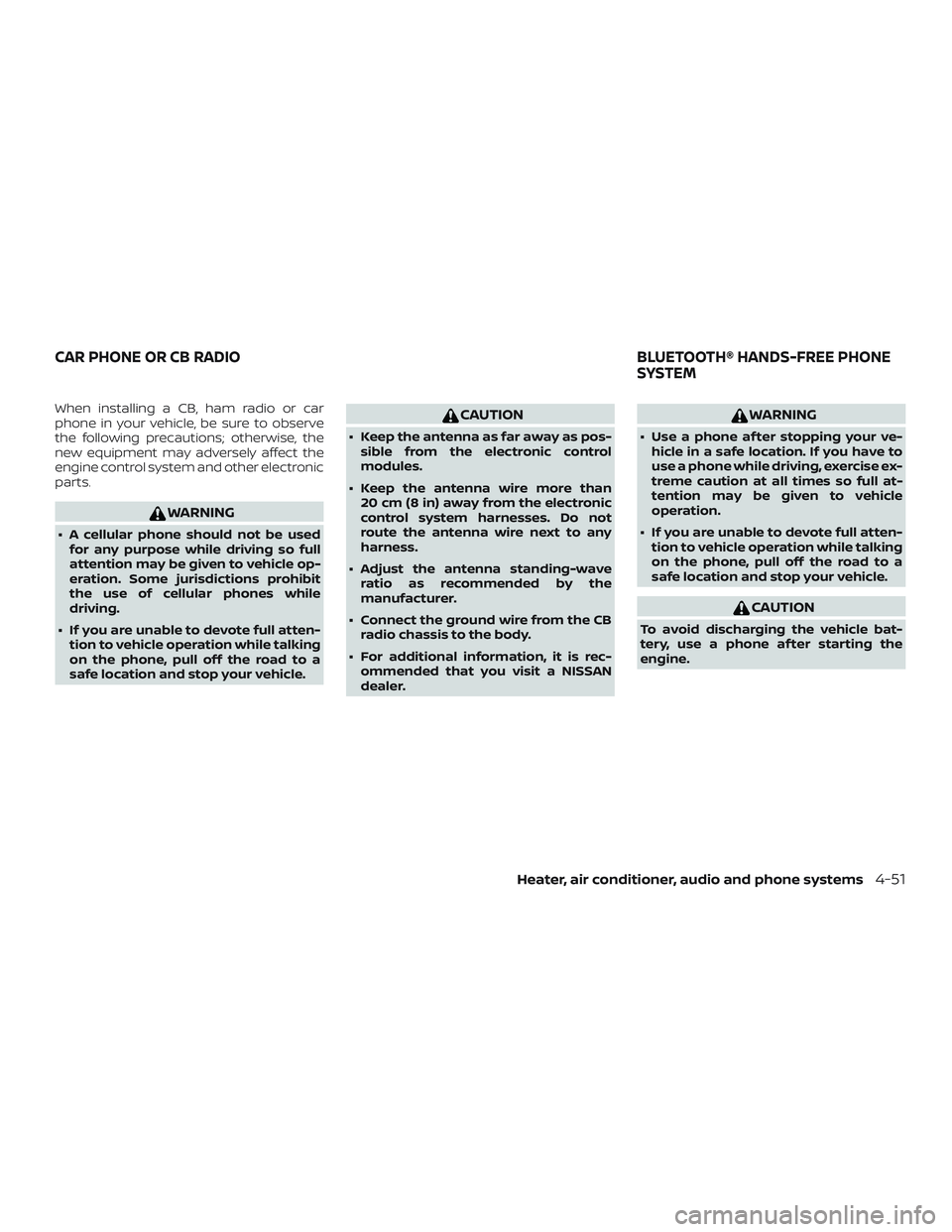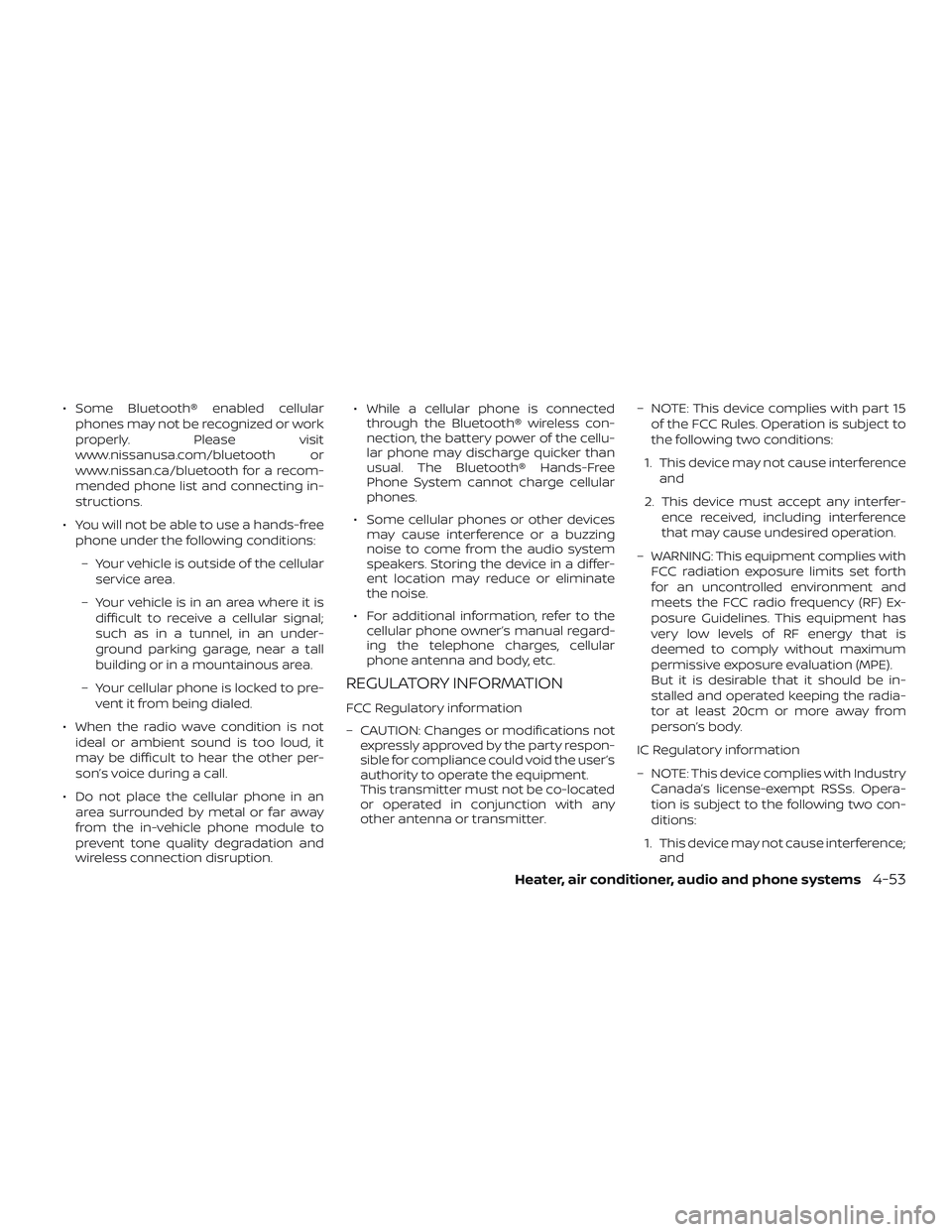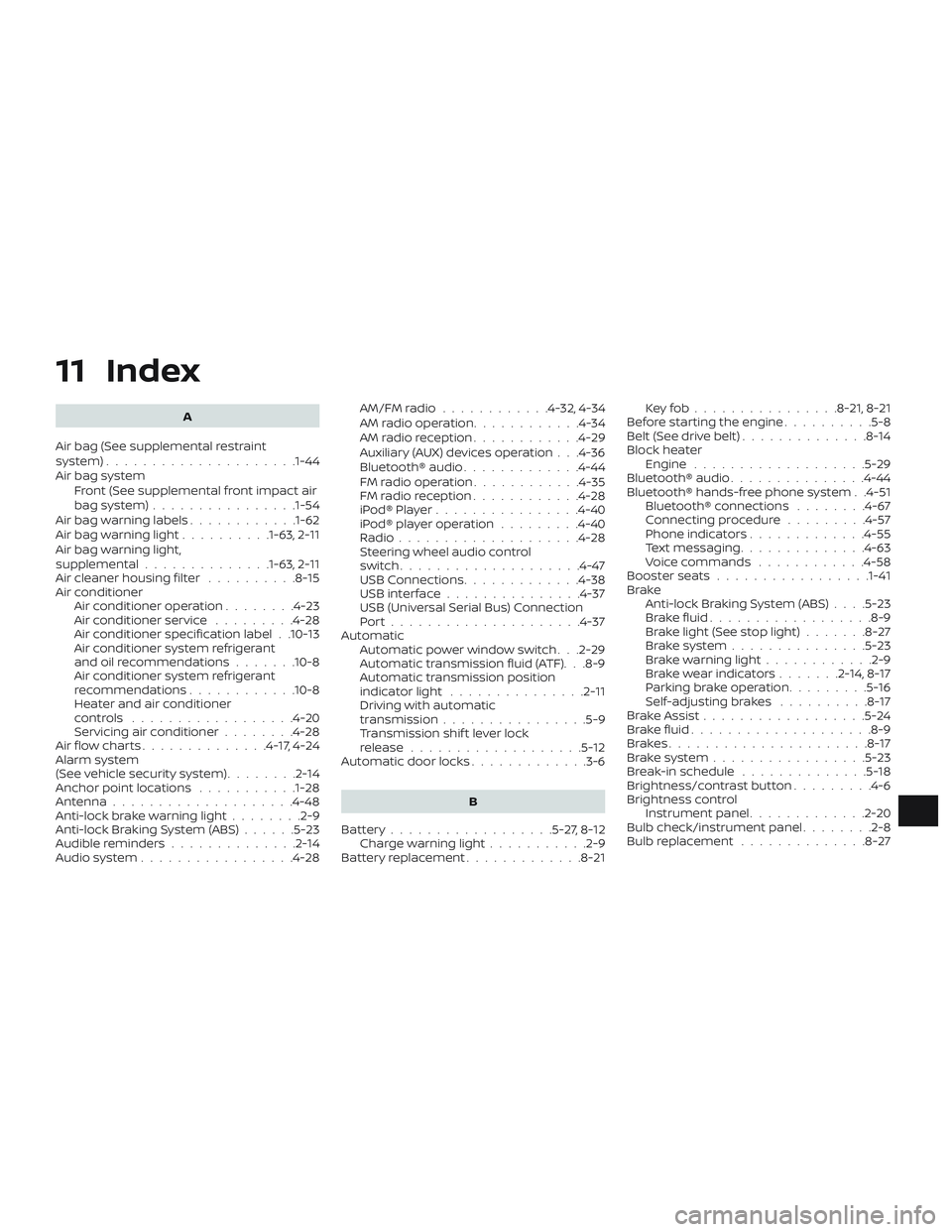radio antenna NISSAN MICRA 2019 Owner´s Manual
[x] Cancel search | Manufacturer: NISSAN, Model Year: 2019, Model line: MICRA, Model: NISSAN MICRA 2019Pages: 346, PDF Size: 4.05 MB
Page 129 of 346

4 Heater, air conditioner, audio and
phone systems
Control panel buttons...........................4-2
How to use the touch-screen .................4-2
How to use the
MENU button ...........4-4
(brightness control) button .............4-6
How to use the VOL (volume) knob /
PUSH
(power)button ...................4-6
Selecting menu from launch bar .............4-6
RearView Monitor ...............................4-7
RearView Monitor system operation ..........4-8
How to read the displayed lines ...............4-9
Difference between predicted and
actual distances ..............................4-9
Adjusting the screen ......................... 4-11
RearView Monitor system limitations .........4-11
System maintenance ........................ 4-12
Vents ........................................... 4-13
Heater (manual) (if so equipped) ................4-14
Controls ..................................... 4-15
Heater operation ............................ 4-16
Air flow charts ............................... 4-17
Heater and air conditioner (manual)
(if so equipped) ................................. 4-20
Controls ..................................... 4-21Heater operation
............................ 4-22
Air conditioner operation ....................4-23
Air flow charts ............................... 4-24
Servicing air conditioner (if so equipped) ........4-28
Audio system ................................... 4-28
Radio ........................................ 4-28
FM radio reception .......................... 4-28
AM radio reception .......................... 4-29
Audio operation precautions ................4-29
FM/AM radio ................................. 4-32
USB (Universal Serial Bus) connection
port......................................... 4-37
iPod®* player operation ......................4-40
Bluetooth® streaming audio .................4-44
Steering wheel switch for audio control ......4-47
Antenna ..................................... 4-48
Siri® Eyes Free (if so equipped) ..................4-48
Requirements ............................... 4-49
Operating Siri® Eyes Free ....................4-49
Troubleshooting guide ......................4-50
Car phone or CB radio .......................... 4-51
Bluetooth®
Hands-Free Phone System .........4-51
Regulatory information ......................4-53
Page 158 of 346

Fade and drif t: As your vehicle moves away
from a station transmitter, the signals will
tend to fade and/or drif t.
Static and flutter: During signal interfer-
ence from buildings, large hills or due to
antenna position (usually in conjunction
with increased distance from the station
transmitter), static or flutter can be heard.
This can be reduced by adjusting the treble
control to reduce treble response.
Multipath reception: Because of the reflec-
tive characteristics of FM signals, direct and
reflected signals reach the receiver at the
same time. The signals may cancel each
other, resulting in momentary flutter or loss
of sound.
AM RADIO RECEPTION
AM signals, because of their low frequency,
can bend around objects and skip along
the ground. In addition, the signals can be
bounced off the ionosphere and bent back
to earth. Because of these characteristics,
AM signals are also subject to interference
as they travel from transmitter to receiver.
Fading: Occurs while the vehicle is passing
through freeway underpasses or in areas
with many tall buildings. It can also occurfor several seconds during ionospheric tur-
bulence even in areas where no obstacles
exist.
Static: Caused by thunderstorms, electrical
power lines, electric signs and even traffic
lights.
AUDIO OPERATION PRECAUTIONS
USB (Universal Serial Bus)
connection port
WARNING
Do not connect, disconnect or operate
the USB device while driving. Doing so
can be a distraction. If distracted you
could lose control of your vehicle and
cause an accident or serious injury.
CAUTION
∙ Do not force the USB device into the
USB port. Inserting the USB device
tilted or up-side-down into the port
may damage the port. Make sure that
the USB device is connected correctly
into the USB port. ∙ Do not grab the USB port cover (if so
equipped) when pulling the USB de-
vice out of the port. This could dam-
age the port and the cover.
∙ Do not leave the USB cable in a place where it can be pulled unintentionally.
Pulling the cable may damage the
port.
The vehicle is not equipped with a USB de-
vice. USB devices should be purchased
separately as necessary.
This system cannot be used to format USB
devices. To format a USB device, use a per-
sonal computer.
In some jurisdictions, the USB device for the
front seats plays only sound without im-
ages for regulatory reasons, even when the
vehicle is parked.
This system supports various USB
memory devices, USB hard drives and
iPod® players. Some USB devices may not
be supported by this system. ∙ Partitioned USB devices may not play correctly.
Heater, air conditioner, audio and phone systems4-29
Page 180 of 346

When installing a CB, ham radio or car
phone in your vehicle, be sure to observe
the following precautions; otherwise, the
new equipment may adversely affect the
engine control system and other electronic
parts.
WARNING
∙ A cellular phone should not be usedfor any purpose while driving so full
attention may be given to vehicle op-
eration. Some jurisdictions prohibit
the use of cellular phones while
driving.
∙ If you are unable to devote full atten- tion to vehicle operation while talking
on the phone, pull off the road to a
safe location and stop your vehicle.
CAUTION
∙ Keep the antenna as far away as pos-sible from the electronic control
modules.
∙ Keep the antenna wire more than 20 cm (8 in) away from the electronic
control system harnesses. Do not
route the antenna wire next to any
harness.
∙ Adjust the antenna standing-wave ratio as recommended by the
manufacturer.
∙ Connect the ground wire from the CB radio chassis to the body.
∙ For additional information, it is rec- ommended that you visit a NISSAN
dealer.
WARNING
∙ Use a phone af ter stopping your ve-hicle in a safe location. If you have to
use a phone while driving, exercise ex-
treme caution at all times so full at-
tention may be given to vehicle
operation.
∙ If you are unable to devote full atten- tion to vehicle operation while talking
on the phone, pull off the road to a
safe location and stop your vehicle.
CAUTION
To avoid discharging the vehicle bat-
tery, use a phone af ter starting the
engine.
CAR PHONE OR CB RADIO BLUETOOTH® HANDS-FREE PHONE
SYSTEM
Heater, air conditioner, audio and phone systems4-51
Page 182 of 346

∙ Some Bluetooth® enabled cellularphones may not be recognized or work
properly. Please visit
www.nissanusa.com/bluetooth or
www.nissan.ca/bluetooth for a recom-
mended phone list and connecting in-
structions.
∙ You will not be able to use a hands-free phone under the following conditions:
– Your vehicle is outside of the cellular service area.
– Your vehicle is in an area where it is difficult to receive a cellular signal;
such as in a tunnel, in an under-
ground parking garage, near a tall
building or in a mountainous area.
– Your cellular phone is locked to pre- vent it from being dialed.
∙ When the radio wave condition is not ideal or ambient sound is too loud, it
may be difficult to hear the other per-
son’s voice during a call.
∙ Do not place the cellular phone in an area surrounded by metal or far away
from the in-vehicle phone module to
prevent tone quality degradation and
wireless connection disruption. ∙ While a cellular phone is connected
through the Bluetooth® wireless con-
nection, the battery power of the cellu-
lar phone may discharge quicker than
usual. The Bluetooth® Hands-Free
Phone System cannot charge cellular
phones.
∙ Some cellular phones or other devices may cause interference or a buzzing
noise to come from the audio system
speakers. Storing the device in a differ-
ent location may reduce or eliminate
the noise.
∙ For additional information, refer to the cellular phone owner’s manual regard-
ing the telephone charges, cellular
phone antenna and body, etc.
REGULATORY INFORMATION
FCC Regulatory information
– CAUTION: Changes or modifications not expressly approved by the party respon-
sible for compliance could void the user’s
authority to operate the equipment.
This transmitter must not be co-located
or operated in conjunction with any
other antenna or transmitter. – NOTE: This device complies with part 15
of the FCC Rules. Operation is subject to
the following two conditions:
1. This device may not cause interference and
2. This device must accept any interfer- ence received, including interference
that may cause undesired operation.
– WARNING: This equipment complies with FCC radiation exposure limits set forth
for an uncontrolled environment and
meets the FCC radio frequency (RF) Ex-
posure Guidelines. This equipment has
very low levels of RF energy that is
deemed to comply without maximum
permissive exposure evaluation (MPE).
But it is desirable that it should be in-
stalled and operated keeping the radia-
tor at least 20cm or more away from
person’s body.
IC Regulatory information
– NOTE: This device complies with Industry Canada’s license-exempt RSSs. Opera-
tion is subject to the following two con-
ditions:
1. This device may not cause interference; and
Heater, air conditioner, audio and phone systems4-53
Page 336 of 346

11 Index
A
Air bag (See supplemental restraint
system) .................... .1-44
Air bag system Front (See supplemental front impact air
bagsystem)............... .1-54
Air bag warning labels ............1-62
Airbagwarninglight..........1-63, 2-11
Air bag warning light,
supplemental ..............1-63, 2-11
Air cleaner housing filter ..........8-15
Air conditioner Air conditioner operation ........4-23
Air conditioner service .........4-28
Air conditioner specification label . .10-13
Air conditioner system refrigerant
and oil recommendations .......10-8
Air conditioner system refrigerant
recommendations ............10-8
Heater and air conditioner
controls ..................4-20
Servicing air conditioner ........4-28
Air flow charts ..............4-17,4-24
Alarm system
(See vehicle security system) ........2-14
Anchor point locations ...........1-28
Antenna ....................4-48
Anti-lock brake warning light ........2-9
Anti-lock Braking System (ABS) ......5-23
Audible reminders ..............2-14
Audio system .................4-28 AM/FMradio............4-32,4-34
AM radio operation
............4-34
AMradioreception............4-29
Auxiliary (AUX) devices operation . . .4-36
Bluetooth® audio .............4-44
FM radio operation ............4-35
FMradioreception............4-28
iPod®Player................4-40
iPod® player operation .........4-40
Radio ....................4-28
Steering wheel audio control
switch....................4-47
USB Connections .............4-38
USBinterface...............4-37
USB (Universal Serial Bus) Connection
Port.....................4-37
Automatic Automatic power window switch . . .2-29
Automatic transmission fluid (ATF). . .8-9
Automatic transmission position
indicatorlight ...............2-11
Driving with automatic
transmission ................5-9
Transmission shif t lever lock
release ...................5-12
Automatic door locks .............3-6
B
Battery..................5-27,8-12 Charge warning light ...........2-9
Battery replacement .............8-21 Keyfob................8-21,8-21
Before starting the engine ..........5-8
Belt(Seedrivebelt)..............8-14
Block heater Engine ...................5-29
Bluetooth® audio ...............4-44
Bluetooth® hands-free phone system . .4-51 Bluetooth® connections ........4-67
Connecting procedure .........4-57
Phone indicators .............4-55
Text messaging ..............4-63
Voice commands ............4-58
Booster seats .................1-41
Brake Anti-lock Braking System (ABS) . . . .5-23
Brakefluid..................8-9
Brakelight(Seestoplight).......8-27
Brakesystem...............5-23
Brakewarninglight............2-9
Brakewearindicators.......2-14, 8-17
Parking brake operation .........5-16
Self-adjustingbrakes ..........8-17
Br
ake Assist ..................5-24
Brakefluid....................8-9
Brakes......................8-17
Brakesystem.................5-23
Break-in schedule ..............5-18
Brightness/contrast button .........4-6
Brightness control Instrument panel .............2-20
Bulb check/instrument panel ........2-8
Bulb replacement ..............8-27